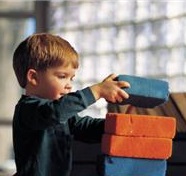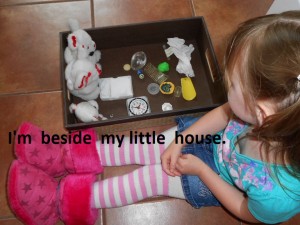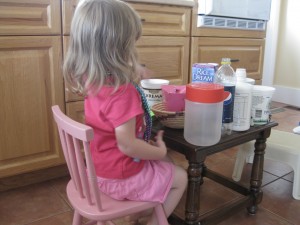Recently, there has been much discussion about play with loose parts and how it contributes to creativity, exploration, imagination, learning, and fun. Of course, all of those in turn support kindergarten readiness. Usually, when we think of children and play we include toys but kids will play with all kinds of stuff. Loose parts are items such as rocks, pine cones, sand, water, pieces of wood, crates, balls, tires, pots, empty plastic containers, sponges, and more.
 Why are loose parts so valuable for play? The easiest way to answer is to watch what kids do when they play with these materials. The play is endlessly varied, as children manipulate, imagine, create, and combine. Kids explore and find solutions to problems. The play is open-ended and child-led. Materials range in size from boxes, logs, and crates that are as large as the kids to tiny objects like pine cones, rocks, corks, buttons, and bits of wood.
Why are loose parts so valuable for play? The easiest way to answer is to watch what kids do when they play with these materials. The play is endlessly varied, as children manipulate, imagine, create, and combine. Kids explore and find solutions to problems. The play is open-ended and child-led. Materials range in size from boxes, logs, and crates that are as large as the kids to tiny objects like pine cones, rocks, corks, buttons, and bits of wood.
 Recently, on a house-cleaning day, my 4-year old “helper” collected some loose parts. A comb, small container of dental floss, some marbles, a shoe horn and other bits kept her busy for half the morning as she created a little house for 2 small bears. Another day the recycling yielded all kinds of plastic containers for playing restaurant. Both these activities stimulated lots of language, asking questions, interacting, and symbolic play.
Recently, on a house-cleaning day, my 4-year old “helper” collected some loose parts. A comb, small container of dental floss, some marbles, a shoe horn and other bits kept her busy for half the morning as she created a little house for 2 small bears. Another day the recycling yielded all kinds of plastic containers for playing restaurant. Both these activities stimulated lots of language, asking questions, interacting, and symbolic play.
 The big disadvantage of loose-parts play is that it is so hard to get rid of anything. How to store all the bits and pieces is another challenge. But one marvelous advantage is that these materials not only have tremendous play value but they are inexpensive. Children will play in all kinds of ways and the learning and fun will be just as varied. For a play-of-the-day today are there some loose parts that your child can use for play activities?
The big disadvantage of loose-parts play is that it is so hard to get rid of anything. How to store all the bits and pieces is another challenge. But one marvelous advantage is that these materials not only have tremendous play value but they are inexpensive. Children will play in all kinds of ways and the learning and fun will be just as varied. For a play-of-the-day today are there some loose parts that your child can use for play activities?
